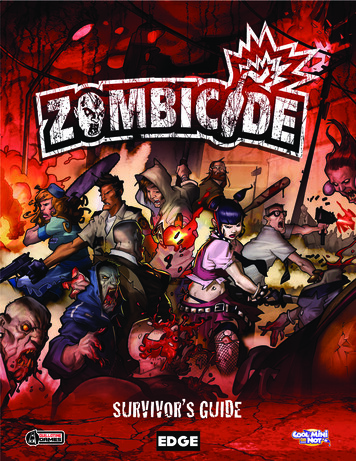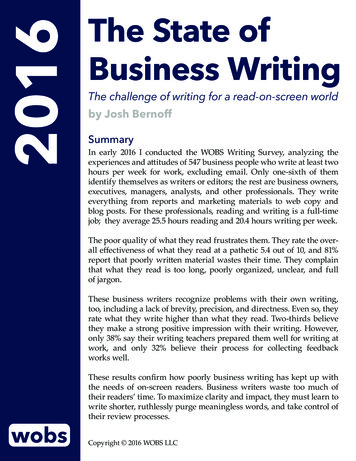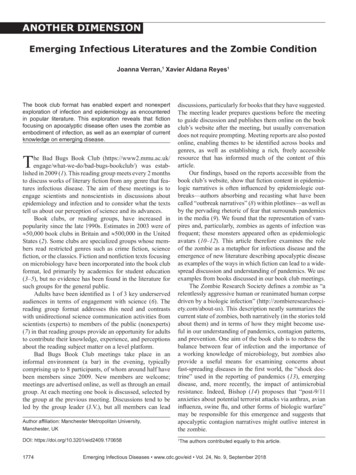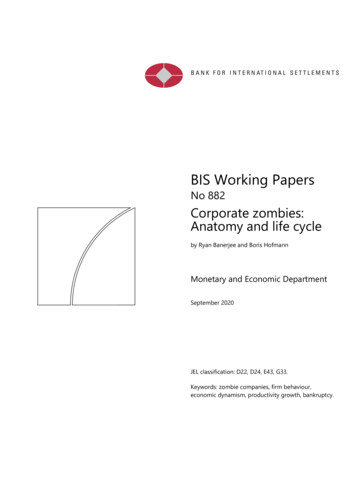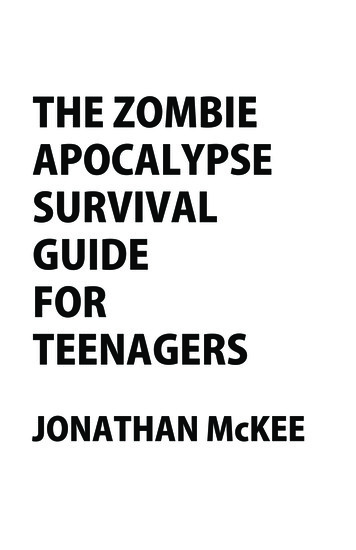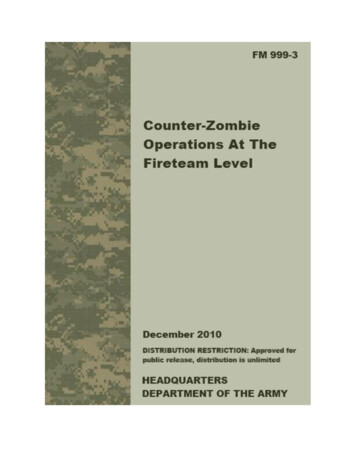
Transcription
FM 999-3HeadquartersDepartment of the ArmyCounter-Zombie Operations at theFireteam LevelTable of ContentsPagePreface iiIntroduction iiiCHAPTER 1 – THE ZOMBIE .1-1The Disease 1-1Zombie Stages, Identification and Action .1-1CHAPTER 2 – ZOMBIE FIGHTING EQUIPMENT .2-1Protective Equipment .2-1Weapons Effective Against Zombies .2-2Weapons Ineffective Against Zombies .2-3CHAPTER 3 – THE FIRETEAM IN COUNTER-ZOMBIE OPERATIONS 3-1Fireteam Formations and Individual Soldier Tasks .3-1The Fireteam on Offense . 3-3The Fireteam on Defense .3-4Joining or Rejoining Friendly Forces .3-6Chapter 4 – WEATHER AND TERRAIN .4-1CHAPTER 5 – CIVILIAN CONSIDERATIONS .5-1APPENDIX A – APPROVED UNIFORMS AT THE ARMY ZOMBIE COMBAT SCHOOL A-1APPENDIX B – DISCLAIMERS AND NOTICES .B-1DISTRIBUTION RESTRICTION: Approved for public release, distribution is unlimited.iii
FM 999-3PrefaceFM 999-3 is the primary doctrinalreference on conducting fire team sizedinfantry operations in a Zombie infestedenvironment in the United States. The term“Zombie” refers to a previously livingbiological organism which continues to movewith purpose while showing no other sign oflife (negative pulse, blood circulation,cognitive function etc).This manual is intended for soldiers of theUnited States Army who are tasked withconducting fire team sized, land-based, nonmechanizedcombatoperationsagainstZombies. This task is not specific to any MOS.For operations involving squads and/orplatoons, refer to FM 999-4, Counter-ZombieOperations at the Squad and Platoon Level.For operations involving Companies andBattalions, refer to FM 999-5, Counter-ZombieOperations at the Company and BattalionLevel.This manual is divided into five chapters:Chapter 1, The Zombie.This chapterdiscusses the most current intelligence on theZombie’s combat capabilities.Chapter 2, Zombie Fighting Equipment.This chapter will explain what equipment isrequired to fight in a Zombie infestedenvironment.Note that some of theequipment is not standard issue, but can bemade with readily available materials and withreadily available tools.Chapter 3, The Fireteam in a Zombieinfested environment.Basic formations,soldier tasks and fireteam tactics in a fourman fire team in counter-Zombie operations.Chapter 4, Terrain and Weather.Thischapter will cover what terrain and weatherconditions are favorable and which are notwhen conducting counter-Zombie operations.Chapter 5, Civilian Considerations.chapter addresses proper proceduresiiThisinvolving armed and unarmed civilians. Thesesituations vary from a hostile civilian forceengaging in armed conflict against the n.In a Zombie infested environment, theZombies are not the only threat to achievingtactical, operational and strategic objectives.Understanding of other field manuals, notablyFM 19-15 Civil Disturbances, FM 3-4 NBCProtection and FM 7-8 Infantry Rifle Platoonand Squad is highly recommended to achievemaximum effectiveness in a Zombie infestedenvironment.Where there is conflictinginformation between FM 999-3 and other fieldmanuals, information on FM 999-3 takesprecedence in a Zombie infested environment.Unless this publication states otherwise,masculine nouns or pronouns do not referexclusively to men.Electronic civilian distribution of thisversion of the manual is authorized through:House of Ryoga: Zombie Survival /zombie-survival/fm-999-3/Army Zombie Combat Schoolhttp://zombiecombatcommand.com/Hard copy civilian distribution of thisversion of the manual is authorized through:Kevadrin’s Wareshttp://www.cafepress.com/kevadrinThe proponent for this publication is the USArmy Zombie Combat School. Send commentsand recommendations on DA Form 2028(Recommended Changes to Publications andBlank Forms) directly toCommandantUS Army Zombie Combat SchoolATTN: ATZN-ZC-NFFort Clement, TX 77499-9778*See Appendix B for more information.
FM 999-3IntroductionZombies are among the mostdangerous hostiles in a combatenvironment. Zombies are known tohave no fear, need no rest and havealmost a sixth sense when it comes todetecting live mammals includinghumans.In order to prevent thisthreat from wiping out the humanspecies,USforcesmustbecontinuously prepared to fight andwin in counter-Zombie operations.The fundamentals of counterZombie operations will read verymuch like a cross between infantry,military police and NBC defense rolesand soldiers, especially leaders, needto know the fundamentals by heart.Because the United States Armyhas never faced a Zombie in battle,one of the primary roles of the UnitedStates Army soldier in a time ofcounter-Zombie operations is toprovidecurrentandaccurateinformation up the chain of command.All intelligence regarding Zombies(weaknesses, strengths, nature ofdisease spread etc.) should be sent tothe battalion S2 (intelligence). Thisdoesnot,however,meantheinformation on this manual is to bedisregarded. This manual is based onintelligence collected from variousZombie outbreaks around the world.Most general rules are consistent, butevery Zombie outbreak is slightlydifferent. The soldier must be able tofind out and deal with unexpecteddevelopments.This manual focuses on the fireteam engaged in counter-Zombieoperations but the soldier mustrealize that this is a small part of amuch broader operation involving keyphases.Phase I. In this phase, the UnitedStates Army engaged in counterZombie operations within the UnitedStates becomes combat ready andrestores or maintains order firstwithin its forward operating bases.US Army units establish Zombiespecific facilities such as containmentareas for contaminated civilians andpersonnel and screening areas todetectinfectedciviliansandpersonnel.Phase II. In this phase, the UnitedStates Army engaged in counterZombie operations within the UnitedStates commences primary offensiveoperations against Zombies.Keyterrain and population centers are tobe occupied or taken from the enemy.These operations will be carried outwith forces battalion size and up.Phase III. In this phase, the UnitedStates Army engaged in counterZombie operations within the UnitedStates will maintain security over keyterrain and population centers whilesending patrols to hunt and killremaining Zombie formations.All counter-Zombie operations areto be executed according to METT-TC.iii
FM 999-3Chapter 1The ZombieThe Zombie is a formidablebattlefield threat and is unlike mostthreats that the United States Armyas an organization and the UnitedStates Army soldier as an lly trains to combat.The DiseaseThe exact nature of the disease isunknown. It is not clear whether it isa virus or a germ. There are twodifferent types of the disease thatcauses Zombification.Type A Zombie Disease is airbornebut is decidedly a weaker version ofthe disease. It does not cause deathor any change in a live human beingupon infection. Once the host (aninfected person) dies, the diseasetakes over and the process ofreanimation as a Zombie begins. Thetime period between death andreanimation is unclear and may bedependent upon certain variablessuch as the environment (humidity,temperature, elevation) and the levelof exposure to the disease.Type F Zombie Disease is fluidborne and is much more potent. TheType F Zombie Disease causessymptoms such as fever, chills,headache, sweats, fatigue, nausea andvomiting typically within the hourfrom initial infection followed bydeath. The exact time between1-0infection, death and reanimationdepends on certain variables such asthe individual’s weight, immunesystem,healthconditionandenvironmental conditions such astemperature, humidity and elevation.Zombie Stages,Identification and ActionThe Zombie looks like a live humanbeing in many ways but exhibits somekey differences.Zombies can beidentified with the following methods.Each method is organized in relationto infection stage.Stage 1, Infected: In this stagea healthy human being isinfected with the disease.Type A Zombie Disease: thereis no change and identificationbetween an infected individualand an uninfected individual isimpossible with the naked eye.Action: Only qualified medicalpersonnel are authorized to taga Type A infected soldier as“Type A Infected.” Soldier is toresumeregularduties.Civilians tagged as “Type AInfected” are to be quarantined.TypeFZombieDisease:Individuals with a Type Finfection can be identified withthe naked eye. Before theindividual exhibits fever, chills,headaches, sweats,fatigue,nausea and vomiting, the
FM 999-3Infected individual’s pupils willnot respond to light or darkness.Action: The infected individualmust be killed immediately andthe brain of the infectedindividual must be destroyed.Stage 2, Recently ReanimatedZombie:In this stage, theZombie can look almost exactlylike a live human being but withsomedifferences.Itsmovementisslowandstaggered, and its arms areextended forward.It mayexhibit a groaning sound. BothType A and Type F infectionslook identical from this stageforward.Action: Neutralize the Zombieby means of destroying itsbrain.Stage 3, Active Zombie: In thisstage, the Zombie is most easilyidentified.Its skin is gray,shriveled and dry.It hasalmost no body fat.Itsmovement is more limited thana Recently Reanimated Zombie.Typically its clothing is eitherheavily damaged or missing. Itmay exhibit a groaning noise.Action: Neutralize the Zombieby means of destroying itsbrain.Stage 4, Neutralized Zombie:In this stage, the Zombie’sbrain has ceased to functionand the Zombie exhibits noactivity.It may look like aStage 2 or Stage 3 Zombie ormaybedecomposedordamaged beyond recognition.Action: If security of the area isestablished by a battalion sizedforce or larger, the NeutralizedZombies are to be burned orcremated. In any other case,no action is to be taken againstNeutralized Zombies.Largefires will attract Zombies to thesource of the fire.Fig. 1.1 Only qualified medical personnelcan identify Type A infections.1-1
FM 999-3Chapter 2Zombie Fighting EquipmentThis chapter is divided into threesections. The first section deals withprotection equipment.The secondsection deals with weapons effectiveagainst Zombies. The third sectiondeals with misconceptions regardingweaponswhicharecommonlybelieved to be effective againstZombies but are either ineffective orpose a danger to the soldier.Protective EquipmentThe soldier is expected to wear anyof the following types of uniforms asdeemed appropriate by equipmentavailability and threat assessment:by Zombies proves to be highly toxicand infects through skin.Assume MOPP 4Improvised Protection: If the unitdoesnothavethenecessaryequipment to assume either Level 1 or2 protection, improvised protectionmay be required. What is required isas follows: Protection from fluids andprotection from ground debris (nails,broken glass etc) and head protection.Eyes and mouths must be protectedfrom fluids.Level 1: This level of protectionshields the soldier from fluids withlittle sacrifice in combat capability.What is worn underneath the GoreTex jacket and pants depends on thecommander or leader’s discretion inregards to weather.HelmetEye protectionMedicalfacemaskorequivalentRubber GlovesGore Tex Jacket (with hoodworn over the soldier’s headunder the helmet)Gore Tex PantsCombat Boots (With rubberboot covers if possible)Level 2: This level of protection isto be assumed if the fluids excreted2-1Fig 2.1 Soldier assumes MOPP 4 in Level 2protection status.
FM 999-3Weapons EffectiveAgainst ZombiesThis section covers weapons that areeffective against Zombies and how toemploy the specific weapon.When operating as a single fireteam,soldiers are to engage with their firearmsonly. A fireteam lacks the mass requiredto fight off a Zombie formation’s advancewith melee weapons.Any fireteamattempting to do so will be surroundedand destroyed.Standard WeaponsM-4/M-16 – The M-4 carbine or theM-16 are effective against Zombiesandduringcounter-Zombieoperations, it is the only personalfirearm to be employed by soldiers.Its accuracy is essential toperforming head shots required toneutralize Zombies.The M-249SAW is not to be employed due toammunitionconsiderations.Resupply in Zombie infested areaswill be very difficult if notimpossible,soammunitionconservation is vital to forcesustainment.The soldier mustrealize that rifle fire will attractZombies. Soldiers should open fireonly if the employment of bayonetsare impractical or impossible.M6, M7 and M9 Bayonet –Bayonets are an ammunitionconserving method of neutralizingZombies and should be preferredmethod of dispatching Zombies.The bayonet must be attached tothe M-4 or M-16. Grip method isslightly different.Although theback hand is on the neck of therifle butt as in regular bayonetdrills, the forehand must grip themagazine, and the rifle heldsideways so that the magazine isparallel to the horizon. This is toensure that the forearm does notget too close to the Zombie.Strong, fast thrusts to the head arerequired to penetrate the hardskull.Non Standard WeaponsSpear–Spearsarehighlyrecommended in counter-Zombieoperations and are essential if thecommander or leader intends toemploy the phalanx (platoon andbigger only).The head of thespear must be able to penetrate ahuman skull and must be shaped ina way that would prevent the headfrom being lodged in the Zombie.Practical in open spaces only.Riot Shield – A riot shield orequivalent is required to employthe phalanx.Steel Pipe – A long, steel pipe canbe used to crush skulls. Practicalin open spaces only.Aluminum Baseball Bat – Baseballbats can be employed to crushskulls. This also represents theshortest melee weapon practicalfor use against Zombies.Swords – Swords are an effectiveweapon against Zombies.Notemust be taken that decapitatedZombie heads still pose a bitehazard.Fig 2.2 The M4 is the weapon of choice in counterZombie operations.2-2
FM 999-3Weapons IneffectiveAgainst ZombiesThis section covers weapons thatare ineffective or impractical for useagainst Zombies.Standard WeaponsM-249 SAW – Conservation ofammunition is paramount incounter-Zombie operations andhigh fire volume will notpsychologicallysuppressadvancing Zombies.M-9 9mm Pistol – Doctrinedemandsheadshotsfromdistances beyond 50m to justifyuseofammunitionunderregular circumstances.M-203 Grenade Launcher –Unless used to launch signalsmoke, its additional weightwill only fatigue the soldier forlittle benefit. A single 40mmgrenade will neutralize only ahandful of Zombies.Non-Standard WeaponsCrowbar – The shape of thecrowbar causes it to lodge itselfin the skull of the Zombie. Toremove it would require thesoldier to pull the Zombie’shead towards himself.Thisexposes the soldier to apossible bite if the Zombie isnot neutralized. Humans havesurvivedgunshotwounds,heavy blows and impalement to2-3the head. This will apply toZombies as well.Chainsaw – Chainsaws are awaste of precious fuel and itsnoise attracts Zombies. It isalso heavy, which will tax theendurance of the soldier.Pitchfork – The head of mostpitchforksarenotsturdyenough to penetrate skull.Flamethrower – Zombies do notfear pain nor death therefore,Zombies will advance into thefire.They will continue toadvance until the heat destroystheir brain. Zombie carcasseswill set fire to the environment,which can endanger friendlyforces and civilians.Axe – This weapon has atendency to lodge itself in itstarget, posing a danger to thesoldier employing it.Crucifix and Garlic – Zombiesarenotaffectedbythepresence of the Crucifix orgarlic.Mallet and Stake – Zombies arenotaffectedbystakepenetration into the heart.Closing in to mallet and stakerange for a skull penetration isextremely hazardous to thesoldier.Fig 2.3 The M249 SAW and other automaticweapons are a waste of precious ammunition.
FM 999-3Chapter 3The Fireteam in Counter-ZombieOperationsDiamondDue to anticipated chaos andseparation in the initial phases of aZombie outbreak, the understandingand mastery of fireteam tactics anddrills is crucial to restoring order andregainingbattlefieldcontrol.All of the following informationapplies when the fireteam is operatingindependently from other formations.Whenconducting counter-Zombieoperations beyond the fireteam level,consult FM 999-4 (Counter-ZombieOperations at the Squad and PlatoonLevel) and FM 999-5 (Counter-ZombieOperations at the Battalion Level).Because Zombies are incapable ofusing firearms, it is not essential thatsoldiers on the move be providedcover fire. There is no concept of“pinning down” Zombies in counterZombie combat.This chapter is separated into 4sections.Section 1, fireteam formations andindividualsoldiertasks.Section 2, the fireteam in offense.Section 3, the fireteam in defense.Section 4, joining and rejoiningfriendly forces.Section 1: FireteamFormations and IndividualSoldier TasksFig 3.1 The diamond formationThe diamond is used when thefireteam needs to move but faces aZombie threatinonegeneraldirection that needs to be addressed.This is considered the Leader:Directsactionagainst Zombies and makes battlefielddecisions in the absence of higherleadership.Reloader: The second senior manin the fireteam is the Reloader. TheReloader serves as the compass andpace man thus ensuring the fireteammoves in the right direction while itsfirepower is still facing the Zombiethreat. The Reloader’s task is to alsoreload empty magazines to maintainthe fireteam’s maximum firepower.Riflemen: Provides firepower tothe fireteam.3-1
FM 999-3Trianglesides by walls, the distance betweenthe two walls being less than a twolane road and ideally the size of a onelane road.Soldier tasks are the same with thetriangle and diamond with onedifference.Reloader: Reloader also checks therear for Zombie threats and engagesif necessary.FileFig 3.2 The triangle formationThe triangle is employed whenfireteamissurroundedinalldirections by Zombies.Soldier tasks are identical to thatof the diamond.TridentFig 3.4 The file formationWhen speed is necessary abovesecurity or when moving in a securearea, the file formation can beemployed as in non-Zombie situations.Fig 3.3 The trident formationThe trident formation is employedwhen the fireteam is protected on two3-2
FM 999-3Section 2: The Fireteam onOffenseFireteamsundertakeoffensiveoperations to cause attrition to theZombie force and/or lure Zombies awayfrom civilians.Fireteams normallyconduct offensive operations as a part ofa larger force. However, the chaos andconfusion that may ensue, especially inthe early hours or days of a Zombieoutbreak may force fireteams to perationsinvolvemovement to contact, reconnaissance andambushes.If a fireteam operating independentlyis doing so because it is cut off from allother units, it is discouraged fromconductingoffensiveoperationsasresupply will be difficult and fireteams donot have the appropriate mass to engageeffectively with melee weapons. Howeverthere are two main situations whereoffensive operations are encouraged.When civilians must be protected.When in danger of being encircledby a Zombie formation and abreakout is possible.Formoreinformationregardingstandard infantry offensive operations,consult FM 7-8, Infantry Rifle Platoon andSquad.Movement to Contact. In counterZombie operations, the purpose ofconducting a movement to contact is tocause attrition to the Zombie force or todraw their attention away from civilians.Prevent detection of fireteam untilit is in the assault.Maintain 360-degree security at alltimes.Maintain at least a 50m distancebetween Zombie formation andfireteam. Ideally keep the distanceat 100m.Do not hesitate to move thefireteam backwards to maintainthe 100-50m distance between theZombie formation and the fireteam.Do not advance the fireteam unlessthe Zombie formation continues tomove away from the fireteam.Reconnaissance. The fireteam mayconduct reconnaissance missions to findvital information regarding the Zombies’combat capabilities without disrupting theZombies’ activities.Information should be passed up tothe battalion S2 if possible.If not possible, a soldier with goodhandwriting is to be assigned therole of scribe and is to record theinformation so it can be passed upto a higher level when possible.Information must includeo Time and dateo Location of Zombieso Direction and speed ofZombieso Number of Zombieso Weatherandterrainconditionso Zombie behavioro Notablestrengthsandweaknesses identifiedo bushes.The fireteam mayconduct hasty or deliberate ambushes inorder to delay or destroy an advancingZombieformation.Again, maintain a 50-100m distancebetween fireteam and Zombies.3-3
FM 999-3Section 3: The Fireteamon DefenseFireteams undertake defensiveoperations to hold key or decisiveterrain, protect itself when unable tomaneuver or protect civilians who areunable to move. This section focuseson defensive operations involving afireteam acting independently ofother US Army units.An independent fireteam shouldavoid being forced into defense due toseveral important factors.A fireteam will almost certainlybe outnumbered by the Zombieformationandmaybeoverwhelmed by its sheer mass.The fireteam may become cutoff from other forces forextended periods of time.Resupplymaybecomeimpossible.Therefore if a fireteam leaderbelieves his fireteam is in danger ofbeing forced into defense, he mustattempt to break contact with theZombie formation and move to anarea that allows the resumption ofoffensive operations. Typically theseareas will be large areas where theZombie infestation has not spread.However,shouldthisbeimpossible, the fireteam leader mustlead his team to a favorable ly paramount in defense.3-4Firing is highly discouraged unlessabsolutely necessary.TypicalFavorablePositions and Actions.certainattributesofdefensive positions.DefensiveThere arefavorableRooftops. Rooftops are an idealdefensive point for soldiers forcedinto defense in urban terrain. For afireteam, the rooftop should be nolarger than a tennis court and shouldbe at least two stories high. Onestory buildings can be scaled byZombies as the converging formationcrushes the Zombies at the base ofthe building. The Zombie pileup willeventually create ramps on all sides ofthe building resulting in perimeterbreach and the fireteam will beoverrun.Steps to follow in securing arooftop.1. Conduct entry of building usingstandardroomclearingtactics.Expect light Zombie presence.Ifthere is heavy Zombie presence,abandon the building and search foranother.2. Find a heavy object and block thedoor. One rifleman covers the door,the other covers the stairwell.3. Find heavy and large objects in thefirst floor and place them to block thestaircase. Ensure that the fireteam isalready on the staircase before thefinal heavy object is put into place.4.Clear the second floor.Findsomething to block the roof accessdoor. Put it on the foot of the roofaccess staircase.Block the roofaccess staircase as conducted on thefirst floor.
FM 999-35. Clear the rooftop. Go down theroof access staircase and bring up theobject that will be used to block theroof access door.Block the roofaccessdoor.6.Fireteam has now secured therooftop.used if no other options are present,but they pose different hazards.Do not fire into Zombies on thestreet around the building. RecentlyReanimated and Active Zombies areharder for other Zombies to climb onthan Neutralized Zombies.Radio Tower. Radio towers alsopose serious lightning strike hazards.Very Steep Mountain or HillTops. If the sides of the mountain topare over 45 degrees steep andmaintains that angle for a distance ofat least 100m, the mountain or hilltopis suitable for defense. The fireteamis to dig a fighting position at the topof the hill to hide its visual and scentsignature.Do not fire into the Zombieformation as Zombies will generallyavoid difficult terrain unless they arecertain of human cturesarefavorable defensive positions becauseit is impossible for Zombies to accesssince they lack the capability to climbor balance on narrow beams. Somebridge support structures also haveareas suitable for use as shelters.Walk way access to the supportstructure should also be destroyed. Ifthis is not possible, soldiers shouldstay on the beams and avoid the walkways.Other Alternatives.There aresome other alternatives that can beWater Tower. Water towers seemlike a good idea but they are veryprone to lightning strikes.Use ifgiven no other choice.Large trees.Large trees aregenerally unfavorable for defense.However, when the alternative isbetween being overrun immediatelyor setting up a defensive position onflat land, it is relatively favorable.Make a makeshift harness using abelt and an LBV to prevent falls.Where the soldier attaches the beltdepends on the nature of the tree.Fig 3.5 This fireteam is in a very strong rooftopposition.Unsuitable Defense Positions.Some positions are simply unsuitablefor defense.Flat land and gentle hilltops.The mass of a converging formation ofZombieswilloverrundefensivepositions set on flat land and gentlehilltops.Islands. Islands are not suitabledefensive positions.Zombies willwalk under water and emerge on theother side of the bank.3-5
FM 999-3Section 4: Joining orRejoining Friendly Forcesforces. The “friendly force” may itselfbe a US Army unit that has beenreanimated as Zombies.Fireteams operating alone arevulnerableincounter-ZombieOperations and must combine withother fireteams or larger formationswhenever possible.Because human beings can bemistaken for Zombies, it is importantthat fireteams and soldiers joining,rejoining with friendly forces takeappropriate action to avoid confusion.WhenMixedwithZombieFormation. Typically this scenariooccurswhenthefireteamissurrounded by Zombies while holdinga key defensive position such as a rooftop or a mountain top. To increasechances of positive identification andrescue, soldiers should take actionsuch as:Popping a smoke grenade.Firing a signal flare.Waving flags or fabric.Using signal eamapproaches friendly forces, soldiers ofthat fireteam must take any of thefollowing action to ensure positiveidentification.Holding weaponshead.Shouting.Waving flags.abovetheSoldiers must use caution whenattempting to join with other friendly3-6Fig 3.6 Smoke grenades make it very clear tofriendly forces of your presence.
FM 999-3Chapter 4Weather and TerrainUnderstandingtheenemy’scapabilities in various weather andterrainincreasesthefireteam’seffectiveness against Zombies.WeatherThe Zombie can operate in almostevery weather condition withoutsignificant impediment to combatcapability.Weather conditions notpresent below have no effect on theZombie.Fig 4.1 Difficult terrain affects Zombies more thanthe soldierCold Weather.The exacttemperature in which Zombies ceaseto function is not known but thetemperature is under 0 degreesCelsius.The Zombie slows down in belowfreezing temperatures before freezingto temporary combat ineffectiveness.A frozen Zombie is not neutralized.When temperatures rise again, itregains its ability to resume hostileactions.Rain. The Zombies’ hill climbingcapabilities are reduced in the rain.Applies only to unimproved surfaces.TerrainSee Chapter 3: The Fireteam inCounter-ZombieOperations;TheFireteam on Defense.4-1
FM 999-3Chapter 5Civilian ConsiderationsThischaptercoversproperprocedures for fireteams actingindependently from other units thatcome across civilians in counterZombieoperations.The definition of civilian incounter-Zombie operations is asfollows: a non-combatant who showsnosymptomsofZombification.A non-combatant who shows er,chills,headaches, sweats, fatigue, nauseaand vomiting is classified as a Zombieandistobeterminated.possible. Lethal force is authorized.If hostile civilians are engaging orengaged by Zombies, fireteam is toavoid that fight.Under no circumstances is afireteam sized unit expected tocontrol or quarantine civilians.Stationary CiviliansCivilians can pose a threat.Civilians under distress may attemptto take weapons and equipment fromsoldiers by any means, includinglethal force.Treat with caution.When dealing with civilians, at leastone soldier in the fireteam must haveeyes on the civilians at all times.Therearefourdifferentclassifications of civilians in counterZombie operations; hostile civilians,disorderlycivilians,stationarycivilians and moving civilians.Hostile CiviliansHostile civilians engage soldierswith force with intent to cause harmto soldiers. Soldiers are authorized toprotect themselves by all means5-1Disorderly CiviliansDisorderly civilians engage inactivities such as looting and riotingbut do not engage soldiers. Fireteamsoperating alone are discouraged fromattemptingtorestoreorder.If disorderly civilians are engagedby Zombies, fireteam leader is todetermine if protection of civilians ispractical and decide whether or not toengage.Stationary civilians are not hostiletowards soldiers and have no intenton moving elsewhere. They may ormay not be armed with firearms.If stationary civilians are engagedby Zombies, fireteam is to assist thestationary civilians by any meanspossible.Moving CiviliansMoving civilians are either on themove or intend to move elsewhere.They may or may not be armed withfirearms.If moving civilians are engaged byZombies, fireteam is to assi
This manual is divided into five chapters: Chapter 1, The Zombie. . tips/zombie-survival/fm-999-3/ Army Zombie Combat School . threats that the United States Army as an organization and the United States Army so

